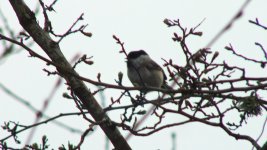OK I will be honest from the off here - I want this to be Marsh Tit!
I can't rule out Coal Tit as nape is not visible and it does appear to have that somewhat scruffy look that you can get with Coal Tits. But can't see start of any white wing bars and central France is on the border of Coal Tit year-round-territory.
As for Willow or Marsh (I did not hear it), looks quite brown above and cheeks are not very white - so it must be Marsh Tit, yes? o (please).
(please).
Thanks for help.
I can't rule out Coal Tit as nape is not visible and it does appear to have that somewhat scruffy look that you can get with Coal Tits. But can't see start of any white wing bars and central France is on the border of Coal Tit year-round-territory.
As for Willow or Marsh (I did not hear it), looks quite brown above and cheeks are not very white - so it must be Marsh Tit, yes? o
Thanks for help.
Attachments
Last edited:







